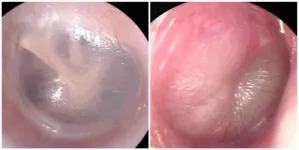(Press-News.org) CLEVELAND—Oral cancers and precancerous mouth lesions are considered especially difficult to diagnose early and accurately.
For one, biopsies are expensive, invasive, stressful for the patient and can lead to complications. They’re also not feasible if repeated screenings of the same lesion are required.
But a team of researchers, led by a clinician scientist at the Case Western Reserve University School of Dental Medicine, has discovered a noninvasive, low-cost test to detect oral cancer, monitor precancerous lesions and determine when a biopsy is warranted.
Their findings, published online March 4 in the journal Cell Reports Medicine, are based on a scoring system linked to the levels of two proteins in cells brushed from suspicious oral lesions of patients at dental clinics or the ear, nose and throat department at University Hospitals (UH).
One of the proteins (human beta defensin 3 or hBD-3) is expressed at high levels in early-stage oral cancer, while the second (hBD-2) is low or unchanged.
The ratio of hBD-3 to hBD-2 in the lesion site—over the ratio of the two proteins on the opposite, normal site—generates a score, called the beta defensin index (BDI).
A score above a predetermined threshold implies cancer; anything below does not. Determining the levels of the proteins and quantifying the BDI is done routinely in a lab.
The BDI was independently validated using identical protocols at CWRU/UH, University of Cincinnati Medical Center and West Virginia University School of Dentistry.
“When we first discovered hBD-3, we saw it acted as a ‘good guy,’ involved in wound-healing and killing microbes," said Aaron Weinberg, chair of the Department of Biological Sciences at the Case Western Reserve School of Dental Medicine and the study’s lead researcher. “When we found it was regulated the same way certain cells grow uncontrollably, we started studying hBD-3 in the context of oral cancer.
“Imagine our surprise when this Dr. Jekyll turned out to be Mr. Hyde,” he said. “We found it was not only promoting tumor growth but was overexpressed in the early stages of the disease, while another member, hBD-2, wasn’t changing. This difference in levels of expression of the two proteins compared to the opposite side in the same patient led us to examine the BDI’s ability to distinguish cancer from benign lesions.”
Weinberg credits School of Dental Medicine instructor Santosh Ghosh for navigating the BDI scoring process.
Head and neck cancer (HNC), of which oral cancer is about 90%, is the seventh-most prevalent malignancy in the world, and developing countries are witnessing a rise in its incidence. HNC makes up about 5% of all cancers worldwide and 3% of all malignancies in the United States, according to the National Institutes of Health. There are about 640,000 cases of HNC per year, resulting in about 350,000 deaths worldwide, mainly in socioeconomically disadvantaged populations and underserved communities.
The study’s lab-based approach, which is now patented, can reduce biopsies in primary care clinics by 95% because it can tell clinicians who actually needs a biopsy, said Weinberg, also secondarily appointed in the Departments of Pathology and Otolaryngology at the Case Western Reserve School of Medicine. The test can also be used in developing countries where oral cancer is rampant and pathology services are questionable or lacking, he said.
The positive data from the lab-based approach has inspired the development of a point-of-care (POC) device in collaboration with Umut Gurkan, the Wilbert J. Austin Professor of Engineering at the Case School of Engineering. The POC diagnostic approach measures the protein ratio and could be used directly in a clinic, providing results within half-hour.
Working through Case Western Reserve’s Technology Transfer Office, a patent for the device is pending, setting up possible manufacturing and clinical validation as a next step.
Discovery, clinical validation studies and POC technology development were supported by the National Institute of Dental and Craniofacial Research, National Cancer Institute, Case Coulter Translational Research Partnership and Ohio Third Frontier Technology Validation and Start-Up Fund.
###
Case Western Reserve University is one of the country's leading private research institutions. Located in Cleveland, we offer a unique combination of forward-thinking educational opportunities in an inspiring cultural setting. Our leading-edge faculty engage in teaching and research in a collaborative, hands-on environment. Our nationally recognized programs include arts and sciences, dental medicine, engineering, law, management, medicine, nursing and social work. About 6,200 undergraduate and 6,100 graduate students comprise our student body. Visit case.edu to see how Case Western Reserve thinks beyond the possible.
END
Case Western Reserve University-led research team discovers new method to test for oral cancer
2024-03-04
ELSE PRESS RELEASES FROM THIS DATE:
Firearm access and gun violence exposure are common in Black and native communities
2024-03-04
A New Jersey Gun Violence Research Center study is the first to provide nationally representative data on gun use, storage and violence within Black and American Indian/Alaskan Native (AIAN) families.
Both Black and native communities have seen increasingly elevated rates of gun violence victimization, including homicide and suicide, according to the Centers for Disease Control and Prevention. In recent years, minorities have become more represented among new firearm owners. Despite this, research on firearm access, storage and use has focused on samples of white adults. This prevents understanding the access Black and native individuals have to firearms, whether they are stored ...
New AI smartphone tool accurately diagnoses ear infections
2024-03-04
A new cellphone app developed by physician-scientists at UPMC and the University of Pittsburgh, which uses artificial intelligence (AI) to accurately diagnose ear infections, or acute otitis media (AOM), could help decrease unnecessary antibiotic use in young children, according to new research published today in JAMA Pediatrics.
AOM is one of the most common childhood infections for which antibiotics are prescribed but can be difficult to discern from other ear conditions without intensive training. The new AI tool, which makes a diagnosis by assessing ...
Screen time and parent-child talk when children are ages 12 to 36 months
2024-03-04
About The Study: This study found a negative association between screen time and measures of parent-child talk when children are 12 to 36 months of age. For every additional minute of screen time, children heard fewer adult words, spoke fewer vocalizations, and engaged in fewer back-and-forth interactions. Interventions aiming to promote early use of language should include support to manage screen time.
Authors: Mary E. Brushe, Ph.D., of the University of Western Australia in Adelaide, South Australia, Australia, is the corresponding author.
To access the embargoed study: Visit our For The Media website at this link https://media.jamanetwork.com/
(doi:10.1001/jamapediatrics.2023.6790)
Editor’s ...
Firearm access and gun violence exposure among American Indian or Alaska native and Black adults
2024-03-04
About The Study: In this nationally representative survey study of 3,542 American Indian or Alaska Native and Black U.S. adults, a substantial percentage of both groups reported living in homes with firearms, storing firearms loaded and unlocked, frequently carrying firearms outside the home, and having been exposed directly and indirectly to gun violence. These findings underscore the need for nuanced public health campaigns and policies and highlight challenges for law enforcement in contexts of racial disparities ...
Associations of medical debt with health status, premature death, and mortality in the US
2024-03-04
About The Study: The findings of this study of 2,943 counties suggest that medical debt is associated with worse health status, more premature deaths, and higher mortality rates at the county level in the U.S. Therefore, policies increasing access to affordable health care, such as expanding health insurance coverage, may improve population health.
Authors: Xuesong Han, Ph.D., of the American Cancer Society in Atlanta, is the corresponding author.
To access the embargoed ...
Low-cost liquid tames tooth decay
2024-03-04
An inexpensive, cavity-fighting liquid called silver diamine fluoride (SDF) works as well as dental sealants to keep tooth decay at bay in a school cavity prevention and treatment program, according to a new study by researchers at NYU College of Dentistry.
The study, which followed more than 4,000 elementary school students for four years and is published in JAMA Pediatrics, shows that SDF is an effective alternative to sealants, and can increase access to dental care while reducing costs.
Dental cavities are the most prevalent ...
More than 1/3 illicit drugs sold on the dark web contain unexpected substances
2024-03-04
Testing of illicit drugs bought online found 35% were not what they said they were, highlighting the urgent need for more local drug testing facilities in Australia to prevent harm and overdose.
The RMIT-led study analysed 103 illicit drug samples sourced from the now-defunct dark web forum Test4Pay in collaboration with the Australian National University, UNSW Sydney and Canadian testing facility Get Your Drugs Tested.
While 65% of samples contained only the advertised substance, the study found 14% of samples had a mixture ...
A better way to deliver fetal therapy for serious genetic disorders
2024-03-04
In a discovery that opens the door to a less invasive way of treating some serious disorders before birth, UC San Francisco scientists have found that delivering medicine through amniotic fluid is as effective as delivering it to the fetal brain via cerebrospinal fluid. The experiment was done in mice with a genetic disorder called Angelman syndrome.
Treating genetic diseases like Angelman in utero could prevent serious symptoms that begin while the fetus is still developing. It’s also easier to access neurons in the fetal brain because the blood-brain barrier that normally acts as a filter ...
Researchers develop amphibian-inspired camouflage skin
2024-03-04
Inspired by amphibians such as the wood frog, investigators designed and synthesized a new type of camouflage skin involving one-dimensional photonic crystal structures assembled in three-dimensional flexible gels.
As described in Advanced Optical Materials, the camouflage skin can quickly recognize and match the background by modulating the optical signals of external stimuli. It demonstrated excellent mechanical performance, self-adaptive camouflage capabilities in response to complex surroundings, and long-term stability in real-world living environments. Bright structural color and mechanical flexibility were maintained even at temperatures as low as -80℃.
The advance ...
Network of quantum sensors boosts precision
2024-03-04
The quantum systems employed in quantum technologies, for example single atoms, are also very sensitive: any interaction with the environment can induce changes in the quantum system, leading to errors. However, this remarkable sensitivity of quantum systems to environmental factors actually represents a unique advantage. This sensitivity enables quantum sensors to surpass conventional sensors in precision, for example when measuring magnetic or gravitational fields.
Noise cancellation using correlation spectroscopy
The delicate quantum properties needed for sensing can be covered up ...




